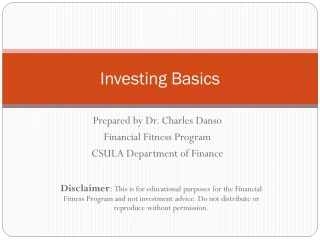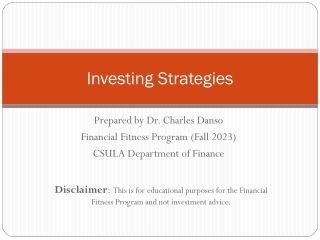Austrian Economics & Investing: Principles and Practices for Financial Success
Explore the intersection of Austrian Economics and investing, delving into the principles of value investing, risk management, entrepreneurship, and more. Gain insights into how economic theory can inform successful investment strategies. Discover the key teachings through the lens of real-world experiences and academic research. This presentation offers a unique perspective on navigating the financial markets with a focus on sustainable growth and prudent decision-making.
Uploaded on Sep 29, 2024 | 2 Views
Download Presentation

Please find below an Image/Link to download the presentation.
The content on the website is provided AS IS for your information and personal use only. It may not be sold, licensed, or shared on other websites without obtaining consent from the author.If you encounter any issues during the download, it is possible that the publisher has removed the file from their server.
You are allowed to download the files provided on this website for personal or commercial use, subject to the condition that they are used lawfully. All files are the property of their respective owners.
The content on the website is provided AS IS for your information and personal use only. It may not be sold, licensed, or shared on other websites without obtaining consent from the author.
E N D
Presentation Transcript
logo Austrian Economics & Investing Austrian Economics & the Financial Markets May 22, 2010 Joseph Calandro, Jr.
Contents Background Introduction Austrian Economics & Investing Investing & ValueInvesting Benjamin Graham Bottom-up v. Top-down Principle 1: Knowledge & the Circle of Competence Principle 2: Risk & the Principle of Conservatism Principle 3: Risk & the Margin of Safety Entrepreneurship & Franchise Value Franchise Value: Management Boom-Bust Conclusion Recommended Reading About the Presenter 1
Background I traded currencies & commodities in the 1990s, & did exceptionally well for 4 years; year 5, I was caught in the Asian Contagion Examining the mistakes I made led me to the study of Austrian Economics & value investing, which was fortunate timing-wise (in a sense) In the late 1990s the new economy was booming: strong parallels with the new era of the 1920s Austrian Business Cycle Theory predicted the boom & bust waves of both business cycles, which is useful information for practicing investors Research published academically including in the QJAE which was expanded & published in book form:Applied Value Investing (NY: McGraw-Hill, 2009) This presentation is my opinion only. Not to attributed to any organization I am or have been affiliated with 2
Introduction Austrian Economics & Investing Good economics facilitates good investing investment students need only two well taught courses How to Value a Business, and How to Think About Market Prices. -- Warren Buffett, 1996 Berkshire Hathaway Annual Report Where there is no free market, there is no pricing mechanism; without a pricing mechanism, there is no economic calculation. -- Ludwig von Mises, Economic Calculation in the Socialist Commonwealth (Auburn: LvMI, 1990 [1920]), p. 28 Economics is the science which studies human behavior as a relationship between ends and scare means which have alternative uses. -- Lionel Robbins, An Essay on the Nature and Significance of Economic Science (Auburn: LvMI, 2007 [1932]), p. 15 3
Investing & Value Investing The capitalist-entrepreneur buys factors or factor services in the present; his product must be sold in the future. He is always on the alert, then, for discrepancies, for areas where he can earn more than the going rate of interest. -- Murray Rothbard, Man Economy & State (Auburn: LvMI, 2004 [1962]), p. 510 The books and the balance sheets are the conscience of business. They are also the businessman s compass. -- Ludwig von Mises, Bureaucracy (Spring Mills, PA: Libertarian, 1996 [1944]), p. 35 Modern value investing continuum Net Asset Value balance sheet reproduction Earnings Power Value based on a level of historical earnings that should be sustainable into perpetuity Franchise Value sustainable competitive advantage Growth Value least tangible & thus most risky 4
Value Investing: Benjamin Graham Benjamin Graham founded value investing in the 1920s-1930s Heavily influenced by the new era boom of the 20s & the subsequent bust/Great Depression Price discrepancy-based strategy: buying assets < liquidation value resulted in a significant price discrepancy or margin of safety Cornerstone of the approach, to this day, & is what differentiates an investment from a speculation for Graham & his students Most famous student is Warren Buffett; others equally as successful, e.g., Seth Klarman, Mario Gabelli, Mitch Julis, etc. Many value investors have substantially outperformed market averages over time 5
Value Investing: Bottom-up v. Top-down Micro v. Macro Action v. Aggregates Fundamental analysis v. Portfolio analysis Price discrepancies v. efficientfrontiers It is certainly legitimate and necessary for economics, in working out an analysis of reality, to isolate different segments for concentration as the analysis proceeds; but it is not legitimate to falsify reality in this separation, so that the final analysis does not present a correct picture of the individual parts and their interrelations. -- Murray Rothbard, Man Economy & State (Auburn: LvMI, 2004 [1962]), p. 270 6
Principle 1: Knowledge & the Circle of Competence The recognition of the insuperable limits to his knowledge ought indeed to teach the student of [investment] a lesson of humility which should guard him against becoming an accomplice in men s fatal striving to [achieve quick & easy returns]... -- F.A. Hayek, Nobel Prize Lecture (December 11, 1974), words in red font were inserted by me The circle of competence : focus on what you know The size of that circle is not very important; knowing its boundaries, however, is vital. -- Warren Buffett, 1996 Berkshire Hathaway Annual Report Validating assumptions via the selective use of experts PawnStars Indirectexperts : the Sears case 7
Principle 2: Risk & the Principle of Conservatism man does not always act correctly from the objective point of view either from ignorance of casual relations or because of an erroneous judgment of the given situation, in order to realize his ends he acts differently from the way in which he would act if he had correct information. -- Ludwig von Mises, Epistemological Problems of Economics (Auburn: LvMI, 2003 [1960]), p. 34 You could be wrong for any number of reasons: quantitative, qualitative &/or behavioral Address all assumptions/adjustments (B/S, P&L, strategic, & growth-related) in each valuation conservatively 8
Principle 3: Risk & the Margin of Safety this world is a world of uncertainty. We shall never be able to forecast the future course of the world with precision. Every action, therefore, involves risk. This risk cannot be eliminated. The man who keeps cash balances suffers the risk that [his] purchasing power may dwindle; the man who invests suffers the risk of loss; and so forth. -- Murray Rothbard, Man Economy & State (Auburn: LvMI, 2004 [1962]), p. 510 They discover discrepancies between present prices of the complementary factors of production and the anticipated prices of the products minus the market rate of interest, and are eager to profit from them. -- Ludwig von Mises, Human Action (Auburn: LvMI, 1998 [1949]), p. 544 Margin of Safety : rule of thumb, price should be at least 30% less than estimated value 9
Value Investing: Entrepreneurship & Franchise Value (1) The business of the entrepreneur is to select from the multitude of technologically feasible methods those which are best fit to supply the public in the cheapest way with the things they are asking for most urgently. -- Ludwig von Mises, Profit & Loss (Auburn: LvMI, 2008 [1951]), p. 10 A profit-seeking enterprise is supported by the voluntary patronage of the public. It cannot subsist if customers do not pour in. -- Ludwig von Mises, Bureaucracy (Spring Mills, PA: Libertarian, 1996 [1944]), p. 117 The elemental physical nature of the good may be only one of its properties; in [some] cases, a brand name, the good-will of a particular company, or a more pleasant atmosphere in the store will differentiate the product from its rivals in the view of many of its customers. -- Murray Rothbard, Man Economy & State (Auburn: LvMI, 2004 [1962]), pp. 665-666 10
Value Investing: Entrepreneurship & Franchise Value (2) The GEICO case: Buffett s franchise investment masterpiece $120 $106.55 $90 $69.00 $60 $44.15 $30 $0 NAV EPV GV Paid ~$70/share--25.6% price premium at the time--growth reflected a 54% margin of safety (Source: Applied Value Investing, p. 56: valuation solely the work of the author) 11
Franchise Value: Management The profit motive is precisely the factor that forces the businessman to provide in the most efficient way those commodities the consumers want to use. -- Ludwig von Mises, Bureaucracy (Spring Mills, PA: Libertarian, 1996 [1944]), pp. 24-25 One of the qualifications required for any higher position is precisely the ability to judge people correctly. He who fails in this regard jeopardizes his chances of success. -- Ibid, p. 41 Successful managers Have entrepreneurial insight & discipline Know how to select, incentivize, develop, & retain talent Effectively assign decision rights Are fanatical about P&L (very, very rare) 12
Boom-Bust (1) Buy during periods of pessimism & low prices; sell during periods of optimism & high prices. -- Benjamin Graham, The Intelligent Investor (NY: Harper, 1949), p. 31 It could be easier doing this if you understand the macroeconomic reasons for the pessimism & optimism Macro-based insights could be used to screen for potential investment opportunities In broadest terms the Austrian [business cycle] theory is a recognition that an extra-market force (the central bank) can initiate an artificial, or unsustainable, economic boom. The money-induced boom contains the seeds of its own undoing: the upturn must, by the logic of the market forces set in motion, be followed by a downturn [or bust]. -- Roger Garrison, The Austrian Theory of the Business Cycle in Light of Modern Macroeconomics, Review of Austrian Economics, Vol. 3, No. 1(1990), p. 7 13
Boom-Bust (2) Invest into a boom & exploit under-priced risk prior to a bust 6 7 5 3 2 4 1 8 Sources: George Soros, The Crisis of Global Capitalism, p. 52 & Applied Value Investing, p. 133 14
Conclusion (1) Pricing & valuation are predominantly about people voluntarily buying & selling, & the resources allocated to produce goods/services they want to buy & sell Buying a security is like buying anything else you likely would not buy a CD based on a cross-section of different musical genres (rock, country, rap, etc.) so why do that for securities? As an investor you must know: what you re buying, why, what you expect to get out of it, & when Value investing is a proven method of doing this over time 15
Conclusion (2) There could be value buying into a privilege early, e.g., business cycles, Burlington Northern (?), etc: be very conservative here The steel manufacturers seeking a tariff, the bankers seeking taxes to repay their government bonds, the rulers seeking a strong state from which to obtain subsidies, the bureaucrats wishing to expand their empire, are all professionals is statism. They are constantly at work trying to preserve and expand their privileges. -- Murray Rothbard as quoted by Joseph Salerno in the Introduction to A History of Money and Banking in the United States (Auburn: LvMI, 2005 [2002]), p. 10 Whenever the word new is used to describe market phenomena--especially by a government official--get ready for a bust (directionally, not timing-wise) 16
Conclusion (3) Good economics--Austrian economics--facilitates good investing But good investing does not necessarily equate to good economics The curious task of economics is to demonstrate to men how little they really know about what they imagine they can design. -- F.A. Hayek, The Fatal Conceit (Chicago: U of Chicago, 1988), p. 76 17
Recommended Reading Austrian Economics Economics in One Lesson by Henry Hazlitt The Mystery of Banking by Murray Rothbard Economics 101 by Murray Rothbard (audio lectures) The Root Causes of the Economic Crisis by Ludwig von Mises America s Great Depression by Murray Rothbard Value Investing Security Analysis 6th Ed. by Benjamin Graham & David Dodd (Seth Klarman, lead editor) Margin of Safety by Seth Klarman Buffett: The Making of an American Capitalist by Roger Lowenstein Applied Value Investing (requires a working knowledge of accounting, finance & strategy; not for beginners) 18
About the Presenter Joseph Calandro, Jr. is the author ofApplied Value Investing(NY: McGraw-Hill, 2009). He is also the Enterprise Risk Manager of a global financial services firm & a finance department faculty member of the University of Connecticut where he designed & taught MBA courses on value investing & risk management. He was previously a financial consultant with IBM Global Business Services Joe has published widely in journals such as theQuarterly Journal of Austrian Economics, theJournal of Alternative Investments, Strategy & Leadership, & a number of others. A list of his publications is available at his SSRN author s page: http://ssrn.com/author=357310 He has also presented papers at conferences in the U.S., U.K., & Canada 19























